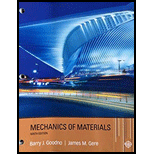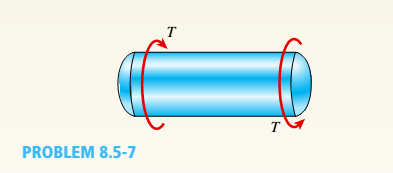
Concept explainers
A cylindrical pressure vessel having a radius r = 14 in. and wall thickness t = 0,5 in, is subjected to internal pressure p = 375 psi, In addition, a torque T = 90 kip-ft acts at each end of the cylinder (see figure),
(a) Determine the maximum tensile stress ctniXand the maximum in-plane shear stress Tmjv in the wall of the cylinder.
(b) If the allowable in-plane shear stress is 4.5 ksi, what is the maximum allowable torque T\
(c) If 7 = 150 kip-ft and allowable in-plane shear and allowable normal stresses are 4.5 ksi and 11.5 ksi, respectively, what is the minimum required wall thickness
(a)
The maximum tensile stress
Answer to Problem 8.5.7P
The maximum tensile stress is
Explanation of Solution
Given Information:
Type of vessel = cylindrical
Radius =
Internal pressure =
Wall thickness =
Torque =
Concept used:
Where
Calculation:
Use the following relation to find the longitudinal stress.
Here, wall thickness is
Substitute
Use the following relation to find the hoop stress.
Substitute
Use the following relation to find the shear stress.
Here, torque is
Express the value of
Substitute
From equation
Find the maximum stress
Use the following relation to find the principal stresses.
Substitute
Calculate the principal stress,
As
Use the following relation to find the maximum in plane shear stress
Substitute
Hence, the maximum shear stress is
Conclusion
The values are found by the concept of longitudinal stress and hoop stress.
(b)
Maximum torque.
Answer to Problem 8.5.7P
The maximum torque is
Explanation of Solution
Given Information:
Concept used:
Calculation:
Find the maximum torque
Substitute
Conclusion:
The maximum torque is calculated by equating 1p , Tmax, r, etc.
(C)
What is the minimum required wall thickness.
Answer to Problem 8.5.7P
The minimum required wall thickness is
Explanation of Solution
Given Information:
Concept used:
Calculation:
Here, allowable in plane shear stress is
Substitute
Express the value of
Here, assumed
Variable are
Evaluate the value of
Evaluate the value of
Substitute
Substitute the value of
Use the trial and error method to find the thickness
Trial
Substitute
Trial
Substitute
Trial
Substitute
Substitute
Express the allowable in plane shear stress.
Substitute
Substitute
As
Hence, from the trial and error method the minimum wall thickness
Conclusion:
The minimum thickness is calculated by trial and error method.
Want to see more full solutions like this?
Chapter 8 Solutions
Bundle: Mechanics Of Materials, Loose-leaf Version, 9th + Mindtap Engineering, 2 Terms (12 Months) Printed Access Card
- Q5:(? Design the duct system of the figure below by using the balanced pressure method. The velocity in the duct attached to the AHU must not exceed 5m/s. The pressure loss for each diffuser is equal to 10Pa. 100CFM 100CFM 100CFM ☑ ☑ 40m AHU -16m- 8m- -12m- 57m 250CFM 40m -14m- 26m 36m ☑ 250CFMarrow_forwardA mass of ideal gas in a closed piston-cylinder system expands from 427 °C and 16 bar following the process law, pv1.36 = Constant (p times v to the power of 1.36 equals to a constant). For the gas, initial : final pressure ratio is 4:1 and the initial gas volume is 0.14 m³. The specific heat of the gas at constant pressure, Cp = 0.987 kJ/kg-K and the specific gas constant, R = 0.267 kJ/kg.K. Determine the change in total internal energy in the gas during the expansion. Enter your numerical answer in the answer box below in KILO JOULES (not in Joules) but do not enter the units. (There is no expected number of decimal points or significant figures).arrow_forwardmy ID# 016948724. Please solve this problem step by steparrow_forward
- My ID# 016948724 please find the forces for Fx=0: fy=0: fz=0: please help me to solve this problem step by steparrow_forwardMy ID# 016948724 please solve the proble step by step find the forces fx=o: fy=0; fz=0; and find shear moment and the bending moment diagran please draw the diagram for the shear and bending momentarrow_forwardMy ID#016948724. Please help me to find the moment of inertia lx ly are a please show to solve step by stepsarrow_forward
- My ID# 016948724arrow_forwardPlease do not use any AI tools to solve this question. I need a fully manual, step-by-step solution with clear explanations, as if it were done by a human tutor. No AI-generated responses, please.arrow_forwardPlease do not use any AI tools to solve this question. I need a fully manual, step-by-step solution with clear explanations, as if it were done by a human tutor. No AI-generated responses, please.arrow_forward
 Mechanics of Materials (MindTap Course List)Mechanical EngineeringISBN:9781337093347Author:Barry J. Goodno, James M. GerePublisher:Cengage Learning
Mechanics of Materials (MindTap Course List)Mechanical EngineeringISBN:9781337093347Author:Barry J. Goodno, James M. GerePublisher:Cengage Learning
